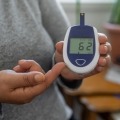4 Tips for Preventing Gestational Diabetes
By Anna Brooks
 Gestational diabetes mellitus (GDM) is a type of diabetes that occurs during pregnancy. While it’s one of the most common pregnancy health complications, gestational diabetes can have serious consequences for both mother and baby. Here are some tips to prevent this condition.
Gestational diabetes mellitus (GDM) is a type of diabetes that occurs during pregnancy. While it’s one of the most common pregnancy health complications, gestational diabetes can have serious consequences for both mother and baby. Here are some tips to prevent this condition.
Gestational diabetes mellitus is a type of diabetes that occurs during pregnancy. While it’s one of the most common pregnancy health complications – globally, up to 20% of pregnant people are affected by it – gestational diabetes can also have serious consequences for both mother and baby. For these reasons, prevention is important, especially for those at a higher risk.
Like type 1 or type 2 diabetes, you’re more likely to develop gestational diabetes if you have a personal or family history of diabetes. Other major risk factors include maternal age and obesity. While some of these factors are out of your control – like family history and genetics – there are lots of lifestyle changes you can make on your own to help prevent GDM.
“Even if you’ve never had [diabetes] and you keep a healthy weight, you can still be at risk,” said Sandra Arevalo, director of community health and wellness at Montefiore Nyack Hospital and spokesperson for the Association of Diabetes Care & Education Specialists.
“It’s very important to know if you’re at high risk and seek help before you get gestational diabetes,” she said. “There are ways to prevent it if you start making changes earlier – even before you start thinking about having a baby.”
1. Increase mindfulness around diet and portion sizes – even before conceiving
GDM rates in the United States have steadily climbed over the last decade, and research has found that obesity or excess weight plays a significant role.
“You’re more likely to develop gestational diabetes if you’re overweight, so one preventative measure is to lose weight before you conceive,” said Camilla Levister, a certified diabetes educator at Mount Sinai Hospital in New York.
Easier said than done, right? Experts like Levister said losing weight doesn’t mean going on a strict diet or eliminating all your favorite foods. It’s about taking stock of your current eating patterns and making changes gradually over time.
Ideally, you should start making these changes before you conceive as you don’t necessarily want to try and lose weight during pregnancy. However, if you’re already pregnant there are still simple steps you can take to prevent increases in blood glucose. Research finds that following low-carb, high-fiber eating patterns (such as the Mediterranean diet) may help prevent GDM.
While generally, you want to reduce the total amount of carbs you consume each meal, that doesn’t mean cutting food groups like fat out altogether. Unsaturated or “healthy” fats are essential for you and your developing baby’s growth (avocados and olive oil are great examples). Avoid or limit trans and saturated fats found in fried and packaged foods.
As recommended by the American Diabetes Association (ADA), some other good foods to add to your diet include:
- Non-starchy vegetables like broccoli and salad greens
- Green beans and bean sprouts
- Nuts and seeds
- Lean proteins like chicken and fish
- Whole, unrefined grains like quinoa and wild rice
Another factor is to be mindful of the portions you consume. “A lot of women think since they’re pregnant, they should eat for two,” Arevalo said. “Something I tell patients all the time is you don’t need to eat more because the baby isn’t big enough to eat a whole plate.”
2. Exercise regularly
We know that exercise combined with a nutritious diet is effective for weight loss and may in turn prevent or delay gestational diabetes. While research on exercise alone as a preventative tool for GDM is inconclusive, one study found the incidence of GDM was 24% lower in participants involved in exercise activities than those who weren’t.
“Regular physical activity before and after conception can help reduce your risk of developing gestational diabetes,” said Levister. “Explore aerobic activities you enjoy doing. If you are pregnant, ask your OBGYN if there are any activities you should modify or avoid.”
Although jogging, swimming, running, and stationary biking are all great forms of aerobic exercise, exercise doesn’t have to mean going to the gym. Low-impact activities like yoga or even a brisk walk are other easy ways to keep your body moving.
3. Get a sufficient amount of quality sleep
Studies have found that poor sleep quality and not getting enough hours of sleep could contribute to a higher risk of GDM and premature birth. Whether or not you’re at risk for GDM, sleep is crucial during pregnancy – both for your health and the health of your growing baby.
Short sleep duration (less than seven hours) has been linked to higher blood sugar levels and GDM in women who are pregnant, though more research is needed in this area. Getting enough sleep during pregnancy is already challenging due to hormonal changes, body aches, an increased need to urinate, and general discomfort – especially during the third trimester. Practicing stress-reduction techniques like mindfulness meditation and reducing screen time before bed may improve overall sleep quality.
4. Monitor your blood sugar
If you’re at risk for developing GDM, Arevalo said the most important advice she can recommend is monitoring your blood sugar. The good news is that keeping track of your blood sugar levels is easy to do from home with glucose meters and continuous glucose monitors (CGM).
Conducting a fingerstick test with a glucose meter isn't ideal, but Arevalo said it’s still a worthwhile measure that can provide you a clearer snapshot of your blood glucose levels. If fingerstick tests feel particularly painful or uncomfortable, she recommends trying a CGM. If you’re at risk for developing gestational diabetes, ask your provider about a CGM.
“Nowadays life is much easier because we have CGMs,” Arevalo added. “With a CGM, you can change your sensor every two weeks and can easily see the results on your phone.”
While monitoring blood sugar on your own is crucial, Arevalo said it’s also important to make and keep appointments with your provider to make sure your glucose levels are under control.
What to do if prevention isn’t enough
While there isn’t a cure for GDM, it is a highly treatable condition. If you’ve been diagnosed with GDM, employing the same strategies for prevention – self-monitoring blood sugar, getting physical activity, and following specialized meal plans – can help manage the condition, according to the ADA. Some people with GDM can hit their blood sugar targets with nutritional therapy and exercise alone; others may need insulin injections and/or other diabetes medications.
In most cases, GDM will disappear after giving birth. Even so, Arevalo added that if you’ve had GDM with one pregnancy, you’re likely to have it with the next one. The risk for developing type 2 diabetes later on is also increased with previous GDM. That’s why prevention continues to be critical during your postpartum period and beyond.
To learn more about GDM or find out if you’re at risk, speak with a healthcare professional you trust.








